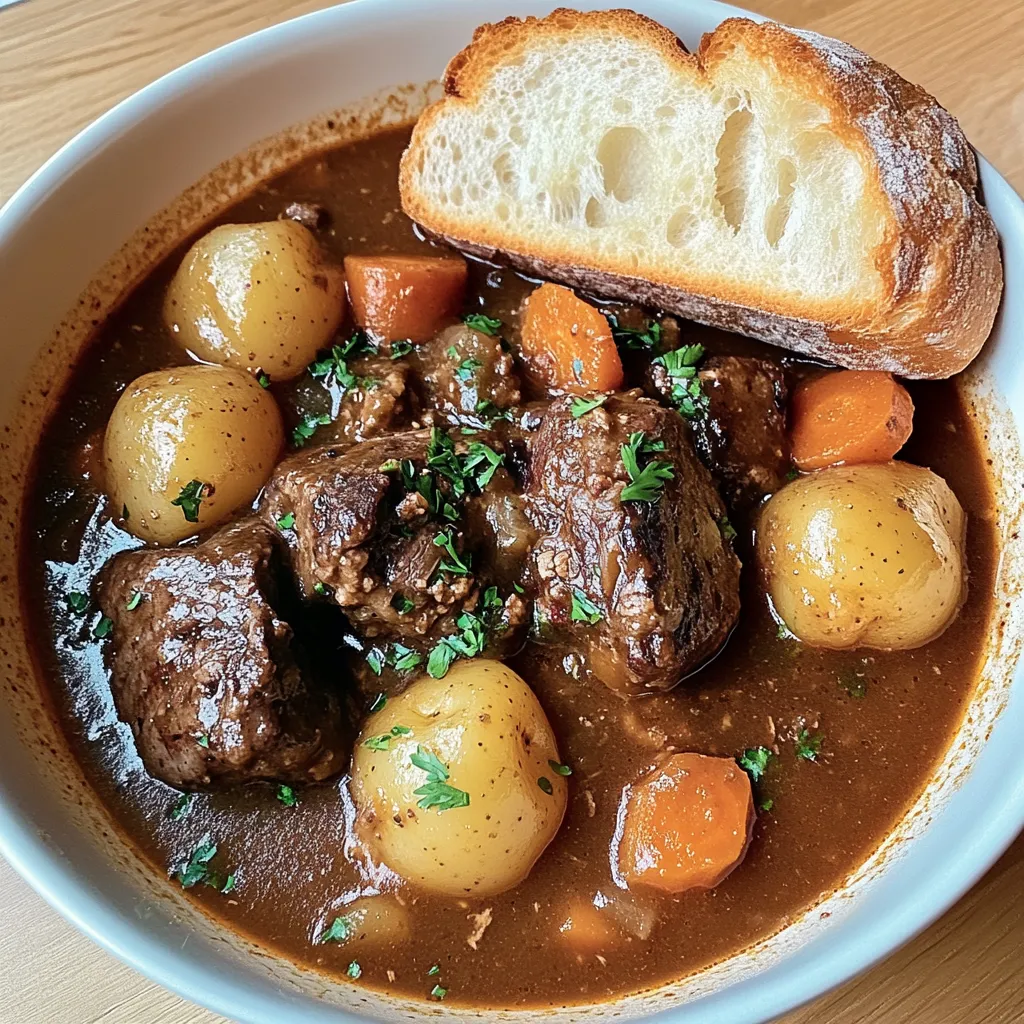 Pin it
Pin it
This beef stew with carrots and potatoes is the definition of cozy on a chilly night. Rich chunks of beef melt into a velvety wine sauce alongside tender vegetables and fresh herbs. I have made it for lazy Sundays and family celebrations alike always earning empty plates and requests for seconds.
It has saved many busy weekdays for me. I can toss it in the oven and get on with other things knowing I will have a delicious dinner ready when we gather around the table.
Ingredients
- Chuck beef: this cut is ideal because it gets tender after long slow cooking pick pieces with a bit of marbled fat for the best texture
- Flour: helps create a flavorful crust on the beef and thickens the sauce use all purpose and dust meat just before browning
- Salt and pepper: season the beef and bring out all other flavors sprinkle generously but taste as you go
- Garlic powder and onion powder: boost the meaty flavor especially helpful if your fresh onions or garlic are mild
- Yellow onion: brings sweet depth when cooked until soft choose firm onions for freshness
- Celery: adds a background aromatic note and gentle crunch buy crisp bright green stalks
- Garlic cloves: fresh garlic infuses stew with savory warmth go for plump firm cloves
- Tomato paste: intensifies the sauce’s richness look for double concentrated paste for the best result
- Beef base: amplifies the meaty flavor cubes or paste both work taste for salt as some brands are quite strong
- Red wine: gives the sauce deep color and a luxurious taste Merlot and Cabernet both suit this stew
- Beef broth: forms the backbone of the sauce low sodium broth offers more control over seasoning
- Worcestershire sauce: provides savory undertones look for one with natural ingredients for best results
- Bay leaves: infuse a subtle earthiness dried or fresh work equally well
- Fresh thyme: adds herbal brightness tie the sprigs for easy removal
- Potatoes: give the stew its heartiness Yukon Gold or red varieties hold up nicely in long cooking
- Carrots: bring sweetness and color choose medium sized carrots for best texture
- Fresh parsley: adds freshness at the end even a sprinkle brings the stew to life
- Baguette for serving: perfect for soaking up every drop of the sauce
Step-by-Step Instructions
- Cube and Season the Beef:
- Cut chuck beef into cubes about the size of large dice removing excess fat as you go but keeping some for moisture. Toss the cubes with flour salt pepper garlic powder and onion powder ensuring every piece is coated. This step is crucial to achieving a thick luscious sauce.
- Prep the Vegetables:
- Dice the onion and celery into small even pieces to ensure everything cooks evenly. Mince garlic cloves finely so the flavor infuses the entire dish.
- Brown the Beef:
- Heat a Dutch oven over medium high with enough oil to cover the base. Brown beef in batches without crowding the pot. Let each piece develop a golden crust by avoiding stirring too soon. Searing is the foundation for deep flavor. Set finished pieces aside.
- Sauté Aromatics:
- Add diced onion celery and minced garlic to the pot’s residual fat. Cook gently until the onion is translucent and the mixture is fragrant. This builds the base of the stew’s sauce.
- Develop the Sauce:
- Stir in tomato paste and beef base and let it cook a few minutes to caramelize these flavors fully. Pour in red wine scraping up browned bits from the pot. Simmer the wine briefly to remove its sharpness.
- Combine and Braise:
- Return the browned beef to the pot. Pour in beef broth add Worcestershire sauce bay leaves and fresh thyme. Stir well to combine. Cover and transfer to a preheated oven set at 320 Fahrenheit placing the pot on the lower rack. Let it cook for about an hour and a half so the meat becomes fork tender.
- Add Vegetables and Finish Cooking:
- After the initial braise add chopped potatoes and carrots making sure they are evenly distributed. Stir and return to the oven for another hour so the vegetables become silky and the sauce thickens further.
- Final Seasoning and Serving:
- Carefully take the pot out taste test for additional salt or pepper. Remove bay leaves and thyme sprigs. Serve bowls of stew garnished with minced fresh parsley and slices of warm baguette.
 Pin it
Pin it
My favorite ingredient is the fresh thyme. It always reminds me of Sunday dinners growing up where the kitchen smelled like a garden and that fragrance snuck into every bowl. I once made this stew with my sister after a long day hiking and we both agreed it was the perfect reward.
Storage Tips
Spoon leftover stew into airtight containers once cooled. Store in the refrigerator for up to four days. The flavors actually improve overnight. For longer storage freeze in individual portions. Thaw overnight in the fridge then reheat gently on the stove splashing in a little broth or water as needed to loosen the sauce.
Ingredient Substitutions
If you cannot find chuck beef try brisket which breaks down in a similar way. No red wine on hand use extra broth with a splash of balsamic vinegar to mimic the acidity. Sweet potatoes work well instead of regular potatoes if you want a twist and mushrooms add extra umami if you skip the carrots.
Serving Suggestions
Serve the stew with fresh baguette for dunking or pour it over fluffy mashed potatoes for an extra hearty meal. Sometimes I sprinkle a bit of grated parmesan while it is still steamy which melts right in. This stew also pairs nicely with buttered noodles or even a crisp green salad on the side.
Cultural and Historical Context
Beef stew is a staple in kitchens around the world loved for its ability to transform basic cuts of meat and humble vegetables into something deeply satisfying. French beef bourguignon and Irish stew use similar techniques simmering tough cuts slowly with a bit of wine and plenty of time making the most of what is on hand. In my house it is a winter classic and always makes me feel connected to generations of cooks before me.
Frequently Asked Questions
- → What cuts of beef are best for this dish?
Chuck beef is ideal as it becomes tender and flavorful during slow cooking, but brisket or stewing beef also work well.
- → Can I substitute the red wine?
Yes, you can use additional beef broth or a splash of balsamic vinegar for depth without wine.
- → How do I make the beef extra tender?
Sear beef in batches and ensure a long cooking time at low heat so it breaks down and stays juicy.
- → Are extra vegetables recommended?
Peas, mushrooms, or parsnips can be added for variety; adjust quantities to your taste preference.
- → What can I serve alongside?
Crusty bread, rice, buttered noodles, or cheesy bread all make excellent pairings for soaking up the broth.
